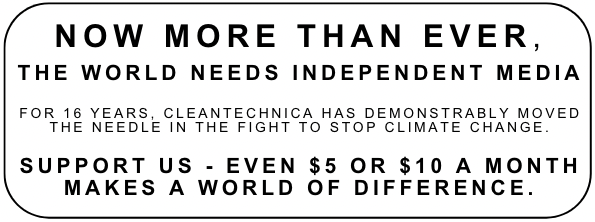
Sign up for daily news updates from CleanTechnica on email. Or follow us on Google News!
Recently, I’ve had some interesting encounters with a big EV fan on Threads. He seems like a nice guy, and his heart is definitely in the right place. Like many of us here, he fiercely defends EVs from FUD and outright lies when he sees them. But, sometimes he’s doing potential EV buyers a disservice by not giving people a realistic idea of what EV ownership is like. Or, worse, he’s handing out bad advice because it sounds good for the EV case and he probably doesn’t know any better.
In this article, I want to explain the importance of being as honest as possible about EVs, warts and all. Then, for the purpose of setting realistic expectations EVs can live up to, I’ll bust a few pro-EV myths that we need to be doing right on.
Why Being Honest Matters, Even When It Sucks
Many of us here are very familiar with EV technology, and we want the world to share in the benefits. So, it’s tempting to share all of the good things and none of the downsides. After all, there are plenty of fossil fuel-funded interests, the less-informed among Republicans, and foreign trolls sharing the downsides all the time, right? With all of the negativity, spending time on EV positivity makes sense.
But, by letting the bad and/or dumb people take care of the downsides, we’re letting them control the narrative and exaggerate the bads. Instead of dealing with 20–45 minute charging, the liars will tell everyone that you’re stopping for 8 hours on road trips, for example. So, it’s important that we be out there talking about the truth of things like charging so that people know that it isn’t that bad.
The other thing we want to avoid is giving people unrealistic expectations. When people buy their first EV, they could end up finding out that it doesn’t meet all of their needs, and this happens AFTER they’ve laid out the money for the car and probably signed themselves up for a years-long loan. Giving people a terrible first-time experience ends up being worse for EVs in the end.
Charging Honesty
It’s totally true that for most EV owners today, charging only takes seconds. The vehicle has far more range than we need on an average day, so we only have to charge at home. When we get home, we plug it in, spending only a few seconds. When we leave home with plenty of charge, we unplug it and drive off. Charging time doesn’t matter because it all happens when we’re eating, spending time with family, relaxing, sleeping, and getting ready to leave again.
But not everyone can do this, even if they want to. Rented houses with landlords that won’t let you rewire, apartments with parking lots, owned houses without driveways, and basically anyone else who can’t plug in at night ends up being out of luck. Being real here means telling people that they’d better make sure there’s home charging if they want a good EV experience.
There’s also the very real problem of road trips. Some EV fanatics hand-wave this away, saying that people hardly ever take road trips. But, even if only 1% of your driving is beyond the point of no return for your home charging setup, nobody wants to buy 99% of a car. People want a car that can do that last 1% of driving.
Making sure people understand how good public charging is getting is important, but even the best EVs using the best charging networks will have challenges we need to be honest about. Charging time does add up. Some rural areas and back roads don’t have sufficient charging yet. Towing cuts your range in half or more, making it tough for even great networks to always cover your needs even on the interstate.
Commercial drivers face a similar problem. Uber drivers, delivery drivers, and other people driving hundreds of miles in cities every day will need to charge away from home. In many places, the infrastructure is ready for them, but in places with lots of EVs, people driving for a living will find to their horror that they need to wait in line for a charge instead of bringing home the bacon.
If people understand all this going in, they won’t be in for any nasty surprises. This, of course, will mean that some drivers choose to sit this out until EVs have more range and there are more plentiful charging options, but these people won’t be out there telling everyone how terrible owning an EV was.
Maintenance Reality
Another fun post often seen on social media is someone pouring in a bottle of window washer fluid. “EV maintenance is super hard,” they say, sarcastically implying that this is basically all that goes into taking care of an EV.
There’s no harm in good fun, but we need to be honest about EVs needing more than wiper fluid, blades, and tire rotations. Regular inspections are a great idea, because they can reveal things like wheels out of alignment, rusted brakes, or a coolant leak. I know everyone thinks that brakes don’t matter in an EV, or that they won’t need any servicing for well over 100,000 miles, but they’re a vital backup system that your EV needs to keep you safe when things go wrong.
Another oft-overlooked EV maintenance need is flushing and filling drive units. Sure, electric motors don’t need regular maintenance and can last for a million miles, but the single-speed gear reducer most EVs have instead of a transmission does use transmission fluid of some kind to keep the gears from wearing themselves down prematurely. Changing that fluid every 50,000–100,000 miles is a good idea, even in manufacturers don’t tell you this.
Again, setting expectations is key. A new EV owner needs to know that things can and do go wrong with EVs, and that they aren’t maintenance free. It’s better for EV drivers to know this going in, appreciate the cost savings compared to ICE maintenance, and not get blindsided by an unexpected repair bill everyone told them would never happen.
Featured image by Jennifer Sensiba.

Chip in a few dollars a month to help support independent cleantech coverage that helps to accelerate the cleantech revolution!
Have a tip for CleanTechnica? Want to advertise? Want to suggest a guest for our CleanTech Talk podcast? Contact us here.
Sign up for our daily newsletter for 15 new cleantech stories a day. Or sign up for our weekly one if daily is too frequent.
CleanTechnica uses affiliate links. See our policy here.
CleanTechnica’s Comment Policy




